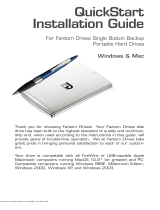13
External Hard Drive
7. Click Yes to create the default folder or your own
folder name. On the Choose Destination Location
screen, click Next to continue. This displays a
screen showing the installation’s Setup Status.
8. Registering your product enables CMS to provide
you with more effective technical support.
Upgrade Info takes you to the CMS web site and
provides the latest information on BounceBack
software.
Register Now takes you to the CMS web site to
register your copy of BounceBack Express.
Register Later continues with the installation.
After returning from the CMS Products registration
website, click OK to continue the installation
process.
A splash screen will be displayed for a few seconds
while the BounceBack Control Center is loaded.
Configuring your first backup
9. When the BounceBack Control Center displays,
you are offered 3 choices for your first backup Full
System, My Documents, and Let Me Choose.
Full System will setup a backup set that includes
all files and folders on your computer. This setting
requires a backup device be connected to the
computer.
Backup Device List identifies available hard drives
for backup use and allows you to select an avail-
able device for the full system backup.
Backup Set Schedule allows you to manually
launch a backup operation or to schedule back-
ups to be launched.
Backup Sizing scans the folders and files on the
system drive and determines the total size of the
files to be backed up.
Note. The size shown will start at 0 and increment, as the size of
each file in the backup set is determined.
10. The BounceBack Installation screen will then
show the estimated time it will take for your first
backup to run completely. Click Backup Now to
continue with the next step.
Clicking Backup Later halts the installation
process with a data set created but no backup
having taken place. If you want to make use of
any of the advanced settings features for the
backup, select Backup Later, and then select
Settings from the BounceBack Control Center.
Note. The sooner you run your first backup, the sooner your
data is protected!
11. After clicking Backup Now, the Backup Scan
and Backup in Progress screens display the
progress of the initial backup.
Note. An option exists on this screen to allow you to view a
detailed file by file progress as the backup process is running.
If the View Detailed Progress option is clicked, the speed of the
backup process will be slowed down substantially.
12. Click OK to use other BounceBack functions—
such as associating a password with a backup
device or creating Backup Sets—or close the
application.

























